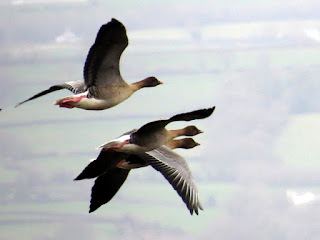Today I made another visit to the SOS Reserve at Venus Pool. It was inspired timing. After days of grey skies and rain a clearance produced bright sunshine. With the sun behind the hides and clear air the camera was busy. The water-level was rather high for ducks. The woodland feeders were very rewarding. Here goes ....
I hope this is after the watershed. Canada Geese goslings on the way?
“Wasn’t that fun”
And off they go still shouting. The shadow of the neck on the closest bird makes it looks like a ‘zip’!
This male Shelduck has now acquired the large swelling at the base of its bill – the female’s bill has a much smaller swelling.
A good view of the breeding plumage features of this departing adult Cormorant – white thigh patch and white plumes on the head and neck.
A rather soggy-looking Little Grebe acquiring summer plumage. The head is going rufous and the pale yellow patch at the base of the bill is developing.
Meanwhile a Common Buzzard circles over. Missing a tail-feather (or two).
Great light on this group of Lapwings explaining one of their country names: ‘Green Plover’. They are not really asleep!
Three Common Snipe are also not asleep. Neither is the drake Shoveler in the foreground. Amazingly there were more than fifty snipe here today.
This individual wandered out on to the grass in front of the main hide. Just look at that complex patterning.
The light around the woodland feeders was great. Most of the usual species were present with a few delights. Here a Great Spotted Woodpecker waits its turn. The red on the nape identifies it as a male.
An ever-cute Blue Tit.
Also cute is this Long-tailed Tit.
This is probably the same male Brambling that I photographed last week. If you look carefully at the back of this bird you can see the pale orange fringes to the black feathers. Within the next two months these will wear away and the whole head and back will become jet black.
I have never seen the feeders so busy and this resulted in some serious-looking disputes. I do not usually photo birds on feeders but this seems to be the time to break that rule and show some of the antics. Here a male Greenfinch looks hopefully for another to vacate a perch.
And no: I did not Photoshop-ed out a perch. It really is holdings its feet like this while in flight.
This male makes off with a prized sunflower seed.
Another approach to landing. Look no wings!
Mr. Angry.
‘Angry’ seems to be trait of male Greenfinches.
“He’s trying to take the food out of my mouth”
A second later: this shows the detail in the wing and tail markings well.
A male resists the approach of a female.....
... and drives her away.
Here is a female Greenfinch showing how much less ‘green’ she is. Note the feint streaking – flammulations – on the flanks.
First example of ‘compare and contrast’: a male Greenfinch sits above a male Chaffinch.
If you think Greenfinches are hard to capture in flight then try capturing Blue Tits.
A highlight today was at least two, probably more, Lesser Redpolls at the feeders. Here is what is possibly a first-year male – there is a hint of pink on the breast which is not usually shown by females. The small red ‘poll’ – crown – is just visible, as is the distinctive yellowish bill.
Compare and contrast #2. Note the size of the Lesser Redpoll on the left and the much larger male Chaffinch on the right.
Compare and contrast #3. A Goldfinch on the left is quite similar in size to the male Lesser Redpoll on the right. This specimen is a much brighter Lesser Redpoll. In winter it is often the small ‘Hitler’ patch under the bill that is most obvious. Not so when they look like this.
A close-up of this Lesser Redpoll.”
(Ed Wilson)




















































